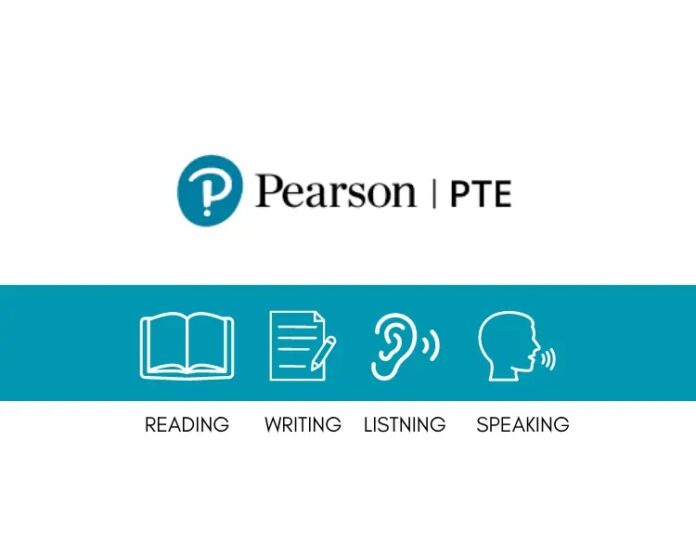The Pearson Test of English (PTE) is a computer-based English language proficiency test widely accepted for academic admissions and visa applications across the globe. Unlike some other English language tests, PTE focuses on real-life English skills, evaluating your abilities in listening, reading, speaking, and writing through integrated tasks. Whether you’re aiming to study abroad, immigrate, or boost your career prospects, understanding the PTE exam can be your first step towards achieving your goals.
Why Choose PTE?

Several factors make PTE a popular choice for test-takers worldwide:
- Computer-Based Format: The entire test is conducted on a computer, which many find less intimidating and more efficient. You’ll type your essays and speak into a microphone, allowing for a consistent and unbiased assessment.
- Integrated Tasks: PTE uniquely integrates different language skills within single tasks. For example, you might listen to a lecture and then summarize it in writing, or read a text and then answer spoken questions about it. This reflects how we use language in real-world scenarios.
- Fast Results: PTE is known for its quick turnaround time for results, typically available within 48 hours of taking the test. This can be a significant advantage for those with tight deadlines.
- Globally Recognized: PTE Academic is accepted by thousands of institutions and government bodies worldwide, including universities in the UK, Australia, Canada, the USA, and New Zealand. It is also approved for various visa categories in several countries.
- Objective Scoring: The computer-based scoring system ensures objectivity and accuracy in evaluating your performance across all sections.
Understanding the PTE Exam Format:

The PTE Academic exam is a single three-hour test divided into three main parts:
- Part 1: Speaking & Writing (54-67 minutes)
- Personal Introduction: (Ungraded) A brief introduction about yourself.
- Read Aloud: Read on-screen text clearly and fluently.
- Repeat Sentence: Listen to a sentence and repeat it verbatim.
- Describe Image: Describe a given image.
- Re-tell Lecture: Listen to a short lecture and summarize it in your own words.
- Answer Short Question: Listen to a question and provide a brief, relevant answer.
- Summarize Written Text: Read a short passage and write a one-sentence summary.
- Write Essay: Write a 200-300 word essay on a given topic.
- Part 2: Reading (29-30 minutes)
- Multiple Choice, Single Answer: Read a text and choose the best answer from the options.
- Multiple Choice, Multiple Answers: Read a text and choose all the correct answers from the options.
- Re-order Paragraphs: Put jumbled paragraphs in the correct order.
- Fill in the Blanks (Reading & Writing): Fill in missing words in a text.
- Fill in the Blanks (Reading): Fill in missing words in a text from a drop-down list.
- Part 3: Listening (30-43 minutes)
- Summarize Spoken Text: Listen to a short audio recording and write a brief summary.
- Multiple Choice, Multiple Answers: Listen to a recording and choose all the correct answers.
- Fill in the Blanks: Listen to a recording and fill in the missing words in a transcript.
- Highlight Correct Summary: Listen to a recording and choose the best summary from the options.
- Multiple Choice, Single Answer: Listen to a recording and choose the best answer.
- Select Missing Word: Listen to a recording and choose the missing word.
- Highlight Incorrect Words: Listen to a recording and identify the incorrect words in a transcript.
- Write from Dictation: Listen to a sentence and write it down verbatim.

Preparing for the PTE Exam:
Effective preparation is crucial for achieving a good PTE score. Here are some key strategies:
- Understand the Format: Familiarize yourself thoroughly with each question type and the time allocated for each section.
- Practice Regularly: Utilize official PTE practice materials, mock tests, and other reliable resources to simulate the actual exam environment.
- Focus on Integrated Skills: Practice tasks that combine different language skills, as this is a key feature of the PTE exam.
- Improve Your Typing Skills: Since the entire test is computer-based, efficient typing is essential for the writing section.
- Work on Your Pronunciation and Fluency: For the speaking section, focus on clear pronunciation, natural intonation, and smooth delivery.
- Enhance Your Listening Comprehension: Practice listening to various accents and types of spoken English.
- Expand Your Vocabulary and Grammar: A strong command of English vocabulary and grammar is vital for all sections of the test.
- Seek Feedback: If possible, get feedback on your speaking and writing performance from teachers or language experts.







